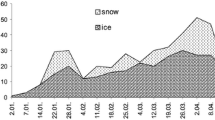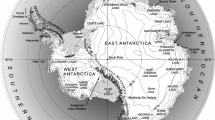Abstract
The growth rates of heterotrophic nanoflagellates (HNAN), mixotrophic cryptophytes, dinoflagellates and ciliates in field assemblages from Ace Lake in the Vestfold Hills (eastern Antarctica) and Lakes Fryxell and Hoare (McMurdo Dry Valleys, western Antarctica), were determined during the austral summers of 1996/1997 and 1997/1998. The response of the nanoflagellates to temperature differed between lakes in eastern and western Antarctica. In Ace Lake the available bacterial food resources had little impact on growth rate, while temperature imposed an impact, whereas in Lake Hoare increased bacterial food resources elicited an increase in growth rate. However, the incorporation of published data from across Antarctica showed that temperature had the greater effect, but that growth is probably controlled by a suite of factors not solely related to bacterial food resources and temperature. Dinoflagellates had relatively high specific growth rates (0.0057–0.384 h−1), which were comparable to Antarctic lake ciliates and to dinoflagellates from warmer, lower latitude locations. Temperature did not appear to impose any significant impact on growth rates. Mixotrophic cryptophytes in Lake Hoare had lower specific growth rates than HNAN (0.0029–0.0059 h−1 and 0.0056–0.0127 h−1, respectively). They showed a marked seasonal variation in growth rate, which was probably related to photosynthetically active radiation under the ice at different depths in the water column. Ciliates' growth rates showed no relationship between food supply and mean cell volume, but did show a response to temperature. Specific growth rates ranged between 0.0033 and 0.150 h−1 for heterotrophic ciliates, 0.0143 h−1 for a mixotrophic Plagiocampa species and 0.0075 h−1 for the entirely autotrophic ciliate, Mesodinium rubrum. The data indicated that the scope for growth among planktonic Protozoa living in oligotrophic, cold extreme lake ecosystems is limited. These organisms are likely to suffer prolonged physiological stress, which may account for the highly variable growth rates seen within and between Antarctic lakes.
Similar content being viewed by others
Author information
Authors and Affiliations
Additional information
Accepted: 7 December 1999
Rights and permissions
About this article
Cite this article
Laybourn-Parry, J., Bell, E. & Roberts, E. Protozoan growth rates in Antarctic lakes. Polar Biol 23, 445–451 (2000). https://doi.org/10.1007/s003009900103
Issue Date:
DOI: https://doi.org/10.1007/s003009900103




